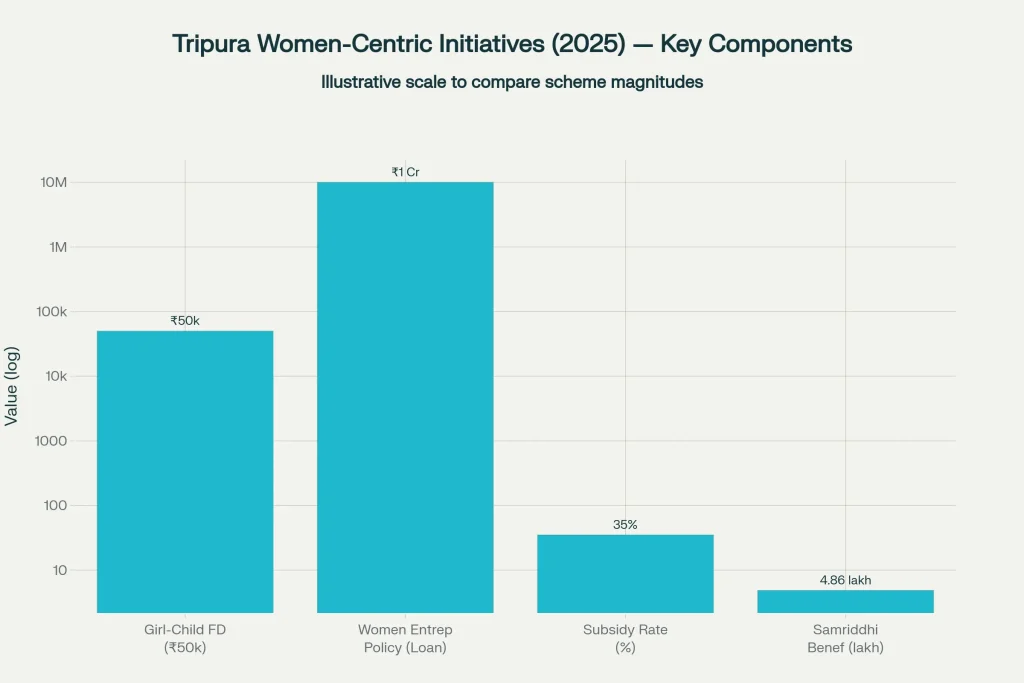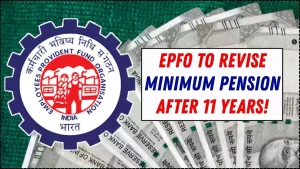Tripura has stepped up with a clear, people-first agenda: protect women’s dignity, remove barriers that hold girls back, and open real pathways into higher education and entrepreneurship. This package of cabinet decisions is not just about announcing new schemes it’s about designing a continuum of support from birth to college to business, so that every girl and woman has a fair shot at security, skills, and self-reliance. The focus on social equality is matched by practical levers: financial incentives that shift household behavior, single-window support for women-led ventures, and a dedicated women’s college to bring higher education closer to rural families. Tripura women empowerment is the thread that ties these moves together. Tripura women empowerment in this context means giving families a reason to invest in their daughters with a fixed deposit at birth in poor households, lowering the true cost of capital for women entrepreneurs, and placing a women’s college in a rural district where it can meaningfully raise tertiary enrollment.

This is a pivotal package built on three pillars that speak to different stages of a woman’s life: a girl-child fixed deposit to deter early marriage and seed future security, a Women Entrepreneurs Policy to make credit affordable and accessible up to ₹1 crore with substantial subsidy support, and a dedicated women’s college at Nalchar to lift rural participation in higher education. Parents get a practical incentive to keep girls in school, young women gain a more accessible pathway to degrees, and would-be founders face fewer hurdles in turning ideas into income. The message is simple: dignity, education, and enterprise must move together if social equality is to be real and lasting. It’s a layered approach safety nets, education, and enterprise that aims to turn dignity into day-to-day agency.
Women’s Dignity and Social Equality
| Program/Decision | What’s New | Who Benefits | Key Terms |
|---|---|---|---|
| Tripura Women Entrepreneurs Policy | High-ceiling loans with meaningful subsidy; preferential terms for women | Women founders, SHG members, first-time entrepreneurs | Up to ₹1 crore; 35% subsidy; single-window industry support |
| Mukhyamantri Balika Samriddhi Yojana | Fixed deposit for girl child at birth in AAY families | Up to two daughters in Antyodaya households | ₹50,000 per girl; matures at 18; designed to discourage child marriage |
| New Women’s College At Nalchar | Dedicated rural women’s college expanding access | Girls and young women in Sepahijala and nearby districts | Closer, safer higher-education option to raise enrolment |
| Samriddhi Abhiyan Under TRLM | SHG-led credit and entrepreneurship drive | Rural women across the state | Targets credit access, enterprise readiness, and income growth |
This slate of decisions reflects a mature understanding of what drives social equality: sustained income security, uninterrupted education, accessible capital, and visible representation. The design choices conditional girl-child deposits, a rural women’s college, and preferential, subsidized loans are tuned to shift norms and outcomes where it matters most. If implementation holds steady and last-mile support remains strong, Tripura can turn these policy levers into lived dignity and long-term opportunity for its girls and women.
Tripura Govt On Women and Divyangjan
The state’s policy direction situates women’s dignity alongside inclusion for persons with disabilities, signaling that social equity is a system goal rather than a standalone program. This broader frame matters: when safety nets, skilling, accessibility, and grievance redressal are designed together, beneficiaries face fewer dead-ends. For women, that brings more reliable access to support services, smoother navigation between schemes, and better protection in vulnerable moments.
Tripura Cabinet Approves New Schemes, Women’s College
The cabinet cleared the Women Entrepreneurs Policy and the Nalchar women’s college while advancing a girl-child fixed deposit scheme with conditions that align incentives to social outcomes. Tying maturity to the age of 18 places a clear nudge against child marriage and toward continued schooling. On the enterprise side, preferential interest and subsidy directly reduce risk for first-time founders and SHG-linked women, improving the odds that micro and small ventures graduate into sustainable businesses.
Tripura Launches Samriddhi Abhiyan To Uplift Rural Women
A policy is only as strong as its last-mile execution. Samriddhi Abhiyan under the state’s rural livelihoods mission is the implementation backbone, making it easier for SHGs and individual women to access bank credit, build business plans, and get market ready. Linking this effort with the Women Entrepreneurs Policy creates a pipeline: group-based savings and microcredit feed into formal loans, while training and mentorship reduce failure rates for early-stage ventures.
Schemes fFor Women, Minorities, Establishment Of New College Soon
The broader slate also recognizes that equitable growth includes minority communities, with targeted small-business support operating alongside women-focused measures. This combination helps local economies diversify and compels departments to coordinate around shared outcomes income growth, school retention for girls, and community-level enterprise density. When families see multiple members benefiting from a daughter’s FD to a mother’s business loan the credibility of the state’s vision compounds.
Scheme for Girls’ Empowerment, Women Entrepreneurship
Eligibility guardrails clarify expectations: up to two daughters can receive the fixed deposit for AAY families; the funds are intended to be accessed at 18, aligning with legal age norms and educational milestones. On credit, a substantial capital ceiling with a robust subsidy lowers break-even thresholds and enables investments in equipment, people, and marketing. This matters for women operating in low-margin sectors who need upfront capital to modernize and scale.
Tripura Government Pledges Commitment to Women’s Empowerment
Policy signals are reinforced by narrative: dignity, safety, and independence are presented not as abstract values but as design principles for programs and delivery systems. That framing encourages departments to measure what matters school continuity, business survival and growth, job creation, and reductions in harmful practices rather than focusing only on disbursal counts. It also invites partnerships with banks, training institutes, and industry bodies to deepen reach.

Gender Budget And Social Welfare Context
The state’s gender budgeting and social welfare ecosystem shows continuity alongside the new push: pensions for vulnerable women, women’s helplines and police stations, shelter facilities, and working women’s hostels all help reduce the cost of seeking help and staying safe. Continuity enables planning families can count on recurring support while accessing newer opportunities in education and enterprise. For frontline workers and SHG leaders, it means clear referral pathways and less fragmentation.
How The Pieces Work Together
- Early-Life Security: The girl-child fixed deposit in Antyodaya households gives low-income parents a clear financial reason to delay marriage and keep daughters in school.
- Education Access: A women’s college in Nalchar reduces distance and social barriers, especially for first-generation learners in rural settings.
- Enterprise Finance: The Women Entrepreneurs Policy unlocks high-ceiling credit with a meaningful subsidy, making expansion investments more feasible.
- Execution Backbone: Samriddhi Abhiyan strengthens SHGs, credit linkages, and readiness, so more women can step into formal finance and markets.
Practical Steps for Applicants
- For AAY Families Expecting A Girl: Ensure delivery in a government hospital; keep documentation ready (AAY status, IDs, birth records). Understand the maturity condition at 18 and plan for the funds as an education or enterprise springboard.
- For Women Entrepreneurs And SHG Members: Prepare a lean business plan with simple financial projections and working capital needs. Identify collateral or guarantee options where relevant, explore sector incentives, and approach the single-window facilitation system early.
- For Students Eyeing Nalchar College: Track the admission calendar, identify preferred courses, and map transport or accommodation needs in advance. Parents should engage early with counseling and scholarship options to smooth the transition from secondary school.
What Success Looks Like
- More Girls Completing Class 12 And Entering College: The fixed deposit incentive, combined with a local women’s college, should push up retention and transition rates.
- Higher Density Of Women-Led MSMEs: Preferential, subsidized capital and SHG pipelines can turn side hustles into registered micro and small enterprises.
- Safer, Easier Access To Help: With women’s helplines, police stations, and shelters in place, women can more readily seek assistance and recover from crises.
- Institutional Representation: As reservations and recruitment policies take hold, more women in public roles will model leadership and reshape norms.
FAQs on Women’s Dignity and Social Equality
How does the girl-child fixed deposit scheme help families?
It offers a ₹50,000 fixed deposit for up to two daughters in AAY families at birth, maturing when the girl turns 18. This creates a financial cushion for education or vocational starts and discourages child marriage by tying benefits to lawful age.
What does the Women Entrepreneurs Policy provide in practical terms?
It enables loans up to ₹1 crore with around a 35% subsidy and preferential terms for women, reducing effective interest costs and improving the economics of starting and scaling a venture. Single-window support helps streamline applications and clear hurdles faster.
What is Samriddhi Abhiyan and why does it matter?
It is a statewide push under the rural livelihoods mission to strengthen SHGs, expand credit access, and build entrepreneurship readiness among rural women. It links grassroots savings and training to formal finance, which is critical for first-time founders.
Why establish a Women’s College at Nalchar?
Placing a dedicated college in a rural district cuts travel time, improves safety and access, and helps first-generation learners continue to higher education. Increased tertiary enrollment for women has compounding benefits for income, health, and community leadership.
















